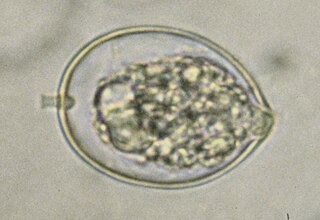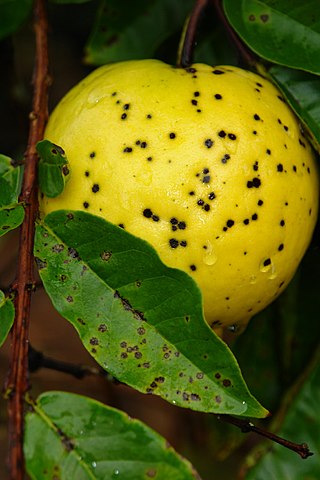
Phytophthora palmivora is an oomycete that causes bud-rot of palms, fruit-rot or kole-roga of coconut and areca nut. These are among the most serious diseases caused by fungi and moulds in South India. It occurs almost every year in Malnad, Mysore, North & South Kanara, Malabar and other areas. Similar diseases of palms are also known to occur in Sri Lanka, Mauritius, and Sumatra. The causative organism was first identified as P. palmivora by Edwin John Butler in 1917.

Phytophthora cactorum is a fungal-like plant pathogen belonging to the Oomycota phylum. It is the causal agent of root rot on rhododendron and many other species, as well as leather rot of strawberries.
Phytophthora nicotianae or black shank is an oomycete belonging to the order Peronosporales and family Peronosporaceae.
Pythium irregulare is a soil borne oomycete plant pathogen. Oomycetes, also known as "water molds", are fungal-like protists. They are fungal-like because of their similar life cycles, but differ in that the resting stage is diploid, they have coenocytic hyphae, a larger genome, cellulose in their cell walls instead of chitin, and contain zoospores and oospores.
Pythium aphanidermatum is a soil borne plant pathogen. Pythium is a genus in the class Oomycetes, which are also known as water molds. Oomycetes are not true fungi, as their cell walls are made of cellulose instead of chitin, they are diploid in their vegetative state, and they form coenocytic hyphae. Also, they reproduce asexually with motile biflagelette zoospores that require water to move towards and infect a host. Sexually, they reproduce with structures called antheridia, oogonia, and oospores.
Pythium graminicola is a plant pathogen infecting cereals.
Pythium volutum is a plant pathogen infecting wheat, barley, and turfgrass. It is known to be sensitive to some of the compounds typically present in selective media commonly used for isolating Pythium spp., so isolation may require alternative methods.

Albugo is a genus of plant-parasitic oomycetes. Those are not true fungi (Eumycota), although many discussions of this organism still treat it as a fungus. The taxonomy of this genus is incomplete, but several species are plant pathogens. Albugo is one of three genera currently described in the family Albuginaceae, the taxonomy of many species is still in flux.

Bremia lactucae is a plant pathogen. This microorganism causes a disease of lettuce denominated as downy mildew. Some other strains can be found on 36 genera of Asteraceae including Senecio and Sonchus. Experiments using sporangia from hosts do not infect lettuce and it is concluded that the fungus exists as a quantity of host-specific strains. Wild species, such as Lactuca serriola, or varieties of Lactuca can hold strains that infect lettuce, but these pathogens are not sufficiently common to seriously infect the plant.

Plasmopara viticola, the causal agent of grapevine downy mildew, is a heterothallic oomycete that overwinters as oospores in leaf litter and soil. In the spring, oospores germinate to produce macrosporangia, which under wet condition release zoospores. Zoospores are splashed by rain into the canopy, where they swim to and infect through stomata. After 7–10 days, yellow lesions appear on foliage. During favorable weather the lesions sporulate and new secondary infections occur.
Phytophthora megakarya is an oomycete plant pathogen that causes black pod disease in cocoa trees in west and central Africa. This pathogen can cause detrimental loss of yield in the economically important cocoa industry, worth approximately $70 billion annually. It can damage any part of the tree, causing total yield losses which can easily reach 20-25%. A mixture of chemical and cultural controls, as well as choosing resistant plant varieties, are often necessary to control this pathogen.

Cercospora sojina is a fungal plant pathogen which causes frogeye leaf spot of soybeans. Frog eye leaf spot is a major disease on soybeans in the southern U.S. and has recently started to expand into the northern U.S. where soybeans are grown. The disease is also found in other soybean production areas of the world.

Cephaleuros is a genus of parasitic thalloid green algae comprising approximately 14 species. Its common name is red rust. Specimens can reach around 10 mm in size. Dichotomous branches are formed. The alga is parasitic on some important economic plants of the tropics and subtropics such as tea, coffee, mango and guava causing damage limited to the area of algal growth on leaves, or killing new shoots, or disfiguring fruit. Spores germinate on plants in the rainy season. Members of the genera may also grow with a fungus to form a lichen that does not damage the plants. There are 17 species in the genus, 13 of which grow between the cuticle and epidermis of infected plants while the remaining four grow intercellularly; interceullular species cause more damage to host plants.

Cephaleuros parasiticus is a plant pathogenic member of the chlorophyta, or green algae. It infects several commercially important crops including tea. Unlike the majority of pathogenic Cephaleuros species, it penetrates the epidermis of plants and is not constrained to subcuticular growth. It has sometimes been misidentified as Cephaleuros virescens. Cortex penetration and the name red rust of tea are marked differentiators of C. parasiticus from its relative C. virescens, which does not penetrate the epidermis. It has been renamed several times as more phylogenetic information has become available.

Phytophthora kernoviae is a plant pathogen that mainly infects European beech and Rhododendron ponticum. It was first identified in 2003 in Cornwall, UK when scientists were surveying for the presence of Phytophthora ramorum. This made it the third new Phytophthora species to be found in the UK in a decade. It was named Phytophthora kernoviae after the ancient name for Cornwall, Kernow. It causes large stem lesions on beech and necrosis of stems and leaves of Rhododendron ponticum. It is self-fertile. It has also been isolated from Quercus robur and Liriodendron tulipifera. The original paper describing the species, stated it can infect Magnolia and Camellia species, Pieris formosa, Gevuina avellana, Michelia doltsopa and Quercus ilex. Since then many other plants have been identified as natural hosts of the pathogen. Molecular analysis has revealed that an infection on Pinus radiata, recorded in New Zealand in 1950, was caused by P. kernoviae. The pathogen was also noted on Drimys winteri, Gevuina avellana, Ilex aquifolium, Quercus ilex, Vaccinium myrtillus, Hedera helix, Podocarpus salignas.
White rust is a disease in plants caused by the oomycete Albugo candida or one of its close relatives. Plants susceptible to this disease generally include members of the Brassica family. White rust has been known to cause agricultural losses in fields cultivating members of this family including broccoli, cauliflower, and Indian mustard. Despite the name, it is not considered a true rust.
Raspberry leaf spot is a plant disease caused by Sphaerulina rubi, an ascomycete fungus. Early symptoms of infection are dark green spots on young leaves. As the disease progresses, these spots turn tan or gray in color. Disease management strategies for raspberry leaf spots include the use of genetically resistant raspberry plant varieties, chemical fungicide sprays, and cultural practices such as pruning and thinning out canes.
Alternaria black spot of canola or grey leaf spot is an ascomycete fungal disease caused by a group of pathogens including: Alternaria brassicae, A. alternata and A. raphani. This pathogen is characterized by dark, sunken lesions of various size on all parts of the plant, including the leaves, stem, and pods. Its primary economic host is canola. In its early stages it only affects the plants slightly by reducing photosynthesis, however as the plant matures it can cause damage to the seeds and more, reducing oil yield as well.
Black rot on orchids is caused by Pythium and Phytophthora species. Black rot targets a variety of orchids but Cattleya orchids are especially susceptible. Pythium ultimum and Phytophthora cactorum are known to cause black rot in orchids.









